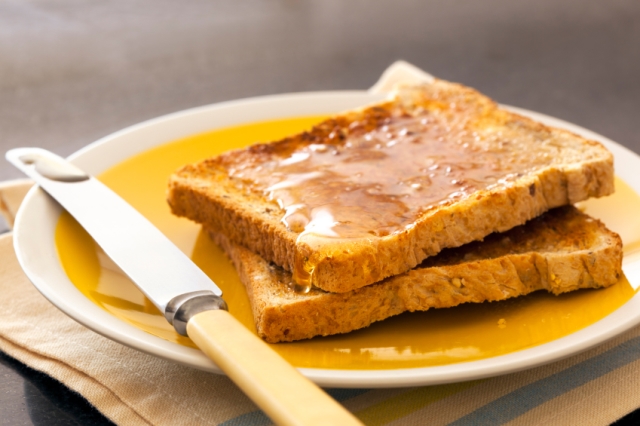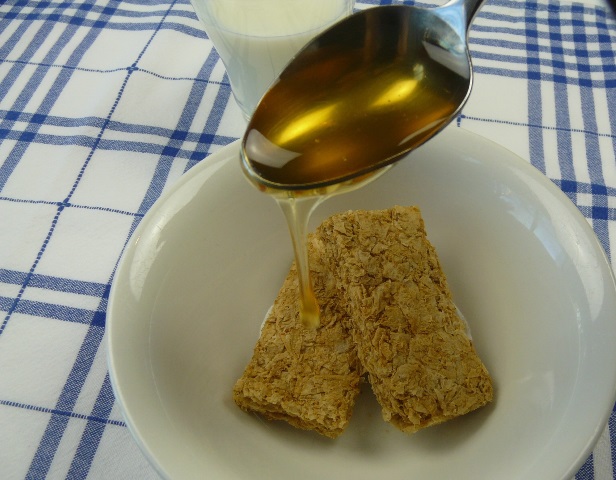- Home
- Blog
- Carbs, Sugars and Fibres
- Honey - is it healthier than sugar?
Honey - is it healthier than sugar?
Written by Catherine Saxelby
on Monday, 03 March 2014.
Tagged: antioxidants, carbohydrates, carbs, fibre, GI, glycemic index, honey, sugar, sugar substitutes, sweetener

An amber fluid made by honey bees (Apis mellifera) from the nectar of flowers, honey has been ‘nature’s sweetener’ for centuries and is frequently marketed as ‘superior’ to sugar. Today we consume over 40 times more sugar than honey yet it remains a favourite flavouring in foods like honey cakes, sauces, breakfast cereals and honey-coated nuts. Here’s how it stacks up side by side with sugar.
With its rich sweetness, I enjoy a spoon of honey in my lemon myrtle tea and to sweeten a bowl of high-fibre porridge oats or a tub of thick Greek yoghurt (honey really adds something special to yoghurt – such a simple dessert). I don’t mind the odd floral honey as long as it’s a mild one such as Yellow Box or Blue Gum. I’ve tried other sweeteners such as agave syrup and barley malt syrup but still come back to good old honey as my long-time fave.
Is honey healthier than sugar?
 Honey – once described as ‘nectar of the gods’ – is often considered a ‘natural’, healthier sweetener than sugar but nutritionally its true advantages are minor, which I know will disappoint many.
Honey – once described as ‘nectar of the gods’ – is often considered a ‘natural’, healthier sweetener than sugar but nutritionally its true advantages are minor, which I know will disappoint many.
It’s an attractive sweetener but like other syrups such as agave, molasses and maple syrup, it must be counted as a form of ‘sugar’ on a weight-loss diet or for anyone with diabetes. Like sugar, it can contribute to tooth decay.
Honey has been a traditional sweetener for thousands of years (think Jewish New Year Rosh Hashanah honey cake), long before we discovered how to extract sugar from sugar cane or sugar beet.
Did you know?
That honey bees are essential for pollination – in fact bees significantly increase both the yield and quality of many crops. Without bees, more than a third of our food would not be available in the current quantity or quality.
Glucose, fructose and other sugars in honey
While sugar is 100 per cent sucrose, honey is made up of around 75 per cent sugars, of which roughly half is glucose and half is fructose (these proportions may vary depending on the source of the nectar). The remaining 20 to 25 per cent is water with a trace of protein, a trace of fat plus a trace of fibre.
This explains why honey has fewer ‘sugars’ or kilojoules/Calories than sugar when you compare them weight for weight. Compare: 100 g white sugar has 1700 kJ/406 Cals whereas 100 g of honey has 1400 kJ/334 Cals.
However few of us eat honey by weight. We’re much more likely to use a teaspoon or tablespoon here and there, so measure for measure, honey has more kilojoules/Calories. That’s because honey is denser and 1 tablespoon weighs 28 grams, whereas a tablespoon of sugar weighs only 16 grams. So, if you’re substituting a tablespoon of honey for sugar, you’re consuming more Calories, not fewer.
Honey’s health benefits
- Honey contains small amounts of plant acids, waxes, gums, pigments and volatile oils which have antioxidant and antibacterial properties. Few analyses of honey have been done but there’s no doubt these natural phyto-chemicals will be an area of great interest in the future. My hunch is that the quantity and type present will depend on which blossoms the bees feed on. What’s more, it’s likely to be artisanal and local apiarist honey that will provide the most.
- Honey contains B vitamins and minerals but the quantities are tiny and not significant nutritionally.
The GI of honey
Most commercially blended honeys have a moderate Glycemic Index or GI of between 45 and 64 which is lower than sugar – white or brown - at 65. The GI varies with the level of fructose – the more fructose, the lower the GI.

In Australia, where I live, these single-flower honeys are derived from native trees such as Stringybark, Red river gum, Yellow Box, Spotted gum, Ironbark, Leatherwood from Tasmania, Tea Tree and Banksia.
For example, Yellow Box has a low GI of 35 whereas a supermarket blended honey has a moderate GI value of 64.
It’s possible that all floral honeys have only modest glycemic effects, but it is too early to say as there hasn’t been sufficient testing. It appears to be related to their fructose-glucose ratio. Like variations in wines, I imagine there are endless variations in the GI and flavour in honeys. Which is nice.
For example, a 2010 study in the European Journal of Clinical Nutrition reported that five German honeys have a low GI. The researchers found that the ‘glycaemic index and insulinaemic index correlated significantly with the fructose content of honey varieties’.
Raw vs pasteurised honey
- Most of the honey in supermarkets has been pasteurised (which means it’s been heated briefly at 60 degrees Celsius and then cooled rapidly), then filtered so it looks clearer and more appealing on the shelf, and is easier to package. This pasteurization step also kills any yeast cells in the honey and prevents the honey from fermenting and slows down the rate of crystallization.
- However, heating also reduces honey’s enzymes and possibly heat-sensitive antioxidants. If honey were your only source of these, it would be critical to eat raw honey. But it’s highly likely you’re eating antioxidants from vegetables, fruit, spices, tea and onions, all of which contain heaps more antioxidants than honey.
- Many people believe that raw honey – with its flecks of bee pollen, honeycomb bits, propolis and bee wing fragments - is more wholesome and nutritious but really there is no hard evidence to suggest that raw honey is better for you than regular honey. If it is, the benefits are marginal and it’s still ‘sugar’ in another form.
- What’s more, there is no uniform standard as to who can use the term ‘raw honey’ in Australia. Many honeys sold as ‘natural’ or ‘raw’ have had some filtering or mild heat treatment to slow down the process of crystallisation so they remain smooth and presentable on the shelves. It’s impossible to know unless you buy direct and watch how the apiarist extracts the honey from the honeycomb.
Creamed honey
Creamed honey (also called whipped honey or granulated honey) is simply honey that’s been whipped or beaten to slow the natural crystallization process. It’s a soft, creamy spread which is thick and easy to spread like smooth peanut butter. Nutritionally it has the same profile as ordinary honey. Many people prefer it as it’s less messy in the kitchen.
The bee’s knees of remedies
Honey has a long history of safe use as a medicine – it appears in so many traditional remedies that one suspects an element of therapeutic truth despite the lack of official documentation in medical journals.
For example:
- A cup of hot water with lemon and honey has long been used to sooth sore throats (researchers think honey acts as a mild disinfectant for the mouth and throat).
- Honey is sometimes taken for its mild laxative effect which researchers now believe may be due to its high content of fructose, a sugar which is often incompletely absorbed in the bowel.
- Honey’s anti-bacterial properties have been well known for over 80 years and there are many reports of its effectiveness as a dressing for minor wounds, skin ulcers and burns.
However, other claims over the years such as a cure for asthma, a tonic against colds, arthritis, anaemia or heart problems do not stand up to scrutiny. They sound tempting so think realistically – if it sounds too good to be true, it probably is. Just enjoy honey for its wonderful honey flavour!
The bottom line
Despite being natural with minimal refining, honey is NOT vastly superior to sugar. Certainly the floral honeys like Yellowbox and Ironbark have a lower GI which slows the rate of digestion and absorption - which is a positive. Certain honeys also have antibacterial qualities which add to their appeal.
Overall, honey is still a form of sugar and needs to be regarded as that – something nice that’s used sparingly to enhance other high-fibre foods such as wholegrain bread or rolled oats or smoothies. It’s my sweetener of choice and I like to buy a single floral honey over the blended supermarket stuff.
You may also be interested in...
References / External articles
Foodwatch
The Good Stuff
The Boring Stuff
© 2025 Foodwatch Australia. All rights reserved
Website by Joomstore eCommerce









